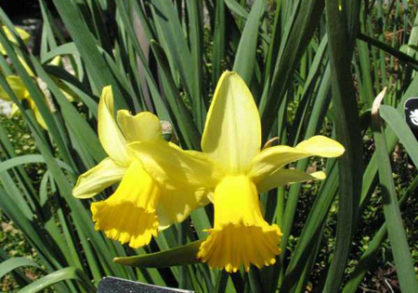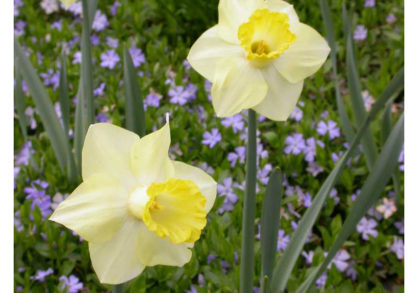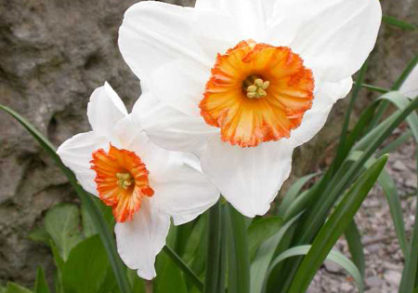Video by Jay Potter
Cultures around the world welcome spring with daffodils. They are blooming now at Cornell Botanic Gardens, where yellow dominates the color palette from almost 100,000 daffodils, representing 56 varieties.
Daffodils are a common name for many plants in the genus Narcissus, predominantly spring-flowering perennials in the amaryllis family, whose species span a native range from southern Europe and northern Africa, with the highest concentration of species in Portugal and Spain.
As Narcissus traveled from its native origin, it was met with great admiration while it gradually spread across the globe. Today, plants in the Narcissus genus grow well in many parts of the world. Their adaptability enables them to grow in diverse climates, especially areas with cool winters and moderate spring temperatures, as they require a period of dormancy during the colder months.
Narcissus species have long been popular garden plants for their blooms’ unmatched beauty, which has resulted in more than 32,000 registered varieties of Narcissus cultivated by plant breeders worldwide.
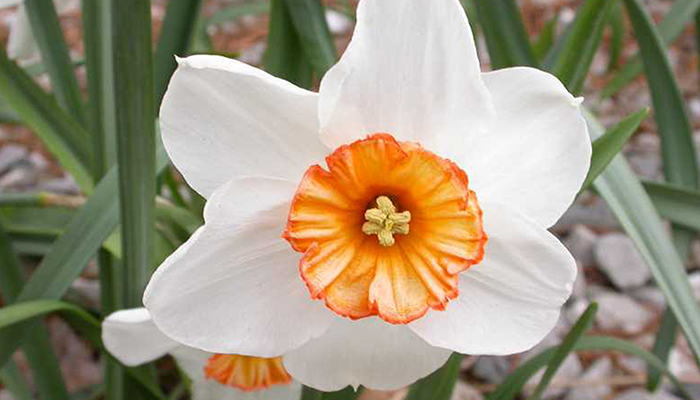
As early as the Roman Empire, Narcissus bulbs were carried across Europe and into parts of the Middle East through early trade routes. Roman gardeners cultivated these flowers for ornamental purposes, and they became symbols of beauty and luxury in Roman villas and gardens.
Early records indicate species of Narcissus were grown in Greek gardens as early at 300 BCE. The roots of the word Narcissus emerged from the Greek myth about a beautiful youth of the same name who was so entranced with his own reflection that the gods turned him into this flower. The Greeks likely played a role in introducing Narcissus to neighboring cultures, where the revered plants took on new meanings and uses.
During the Medieval period, monks and merchants continued to carry Narcissus over land. Monks and herbalists grew the bulbs in monastery gardens across Britain, France, Germany, and Italy for their medicinal properties. Plants were used to remedy wounds and respiratory issues and were added to “love potions.”
The common name “daffodil” originated from the Dutch words “affo dyle,” meaning “that which comes early.” In Wales, the first daffodils bloom in early March, and are often worn as a national symbol. In many European countries, daffodils symbolize resurrection and renewal, making them a popular flower during Easter celebrations. The yellow color of daffodils is often associated with the light of the sun and the rebirth of life.
Today, Narcissus is an important part of many European traditions. Because Narcissus blooms are closely linked with the arrival of spring, they are often a part of spring festivals and featured in spring bouquets.
Narcissus plants made their way to China and throughout Southeast Asia via the Silk Road and water routes from the Mediterranean and Persia. The species Narcissus tazetta appeared in China as early as 690 CE and is one of the most favored flowers of Chinese New Year traditions as a symbol of good fortune and prosperity. Often called “water fairy flowers” or “Chinese sacred lilies,” they are frequently grown in a shallow dish of water and pebbles.
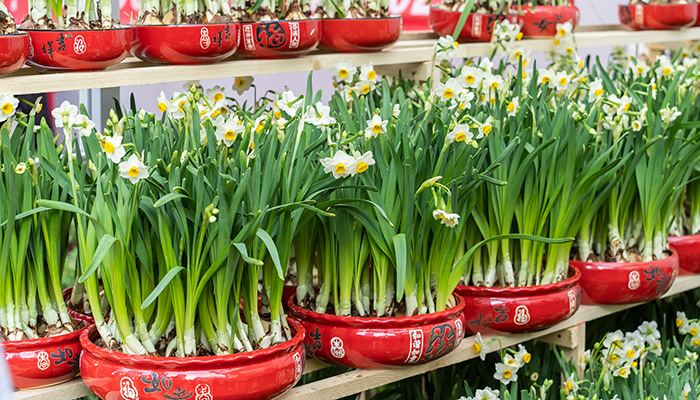
It is believed that Narcissus tazetta arrived in Japan and Korea by way of China between 14th and 16th centuries. Known as suisen, or Japanese daffodil, it is used in traditional Japanese flower arranging (ikebana) especially in winter or New Year displays to represent simplicity, purity, and natural beauty. In Korea, Narcissus is not tied to any specific ritual holiday but appears in traditional Korean ink paintings and folding screens, often alongside other symbolic plants like orchids, bamboo, and plum blossoms.
It wasn’t until the 17th century that Narcissus species reached North America by European colonists and quickly became popular ornamental plants. The bulbs are widely cultivated in gardens, parks, and landscapes throughout temperate regions of the United States and Canada. As a symbol of hope and resilience, daffodils are sometimes used in cancer awareness campaigns by the American Cancer Society. Narcissus likely made its way to South America closer to the 18th and 19th centuries, through the European horticultural trade.
People across cultures through the ages have been attracted to this springtime beauty, which has come to embody hope, resilience, and renewal for all who encounter them.
Whether you are able to enjoy Narcissus species within our gardens or explore them from home in our digital collection below, we invite you to revel in the beauty of these harbingers of spring.
EXPLORE DAFFODILS
Explore a sampling of the 56 varieties daffodils we grow to compare their variety of shapes, sizes and subtle color differences.
